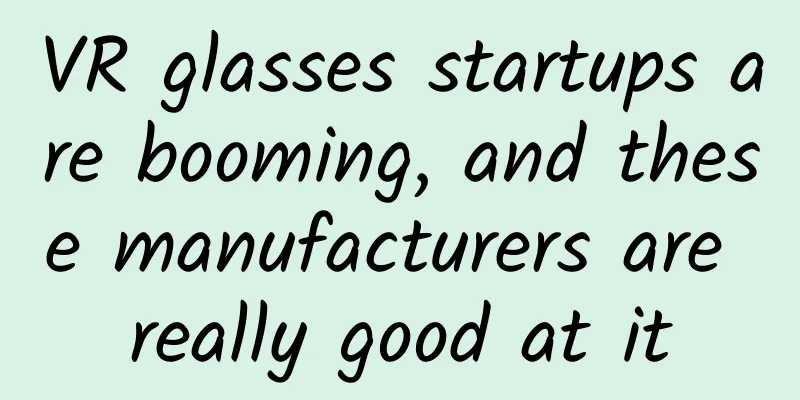VR glasses startups are booming, and these manufacturers are really good at it

|
On March 26, 2014, Facebook spent $2 billion to acquire virtual reality equipment company Oculus, igniting the public's enthusiasm for virtual reality. Although the user market has not yet exploded, entrepreneurs in this field have already been on the road. In China alone, there are currently more than 50 VR glasses-related products on the market and on sale. In Shenzhen, there are even more entrepreneurs ready to make a move. As for the specific products, there are also various tricks and gimmicks. It must be said that entrepreneurs in related fields really know how to play. For those who speculate on concepts, how big is the market for this? When asked when the super cool virtual reality glasses that exist in Hollywood movies will be launched, Facebook CEO Zuckerberg replied, "It may take 5 or even 12 years to realize such a product", which means that Oculus will not be able to make the dream come true until 2027. However, the response of the virtual reality glasses market is much more optimistic than this. From the rumor that the E3 Sony "Dream God" VR glasses will be launched in 2016 with a price of nearly 3,000 yuan, to Google's virtual reality glasses ViewMaster priced at only 30 US dollars, to the domestic Baofeng Video Audio and Video even launching a paper shell version of "Baofeng Magic Mirror" for 9 yuan without free shipping, the virtual reality glasses market has grown explosively for a while, and the Oculus team also announced that the consumer version of Oculus Rift will be launched in the first quarter of 2016, and may be available for pre-order at the end of 2015. Nowadays, heavyweight players such as Google and Facebook have entered the virtual reality glasses market, and traditional hardware manufacturers such as Samsung and Sony have also joined the market. There are many entrepreneurs in China around virtual reality glasses, and "Baofeng Magic Mirror" is considered to be the creator of the myth of Baofeng Video's daily limit. Although virtual reality glasses are popular nowadays, it also raises a question for everyone: how big is the market for virtual glasses that so many giants and entrepreneurs have joined the market? In early April this year, investment bank Digi-Capital released a latest report, saying that by 2020, the market size of virtual reality equipment will be only 30 billion US dollars. However, other third-party research data show that after the popularization of virtual reality technology, the market size of games and videos alone is likely to exceed 1 trillion yuan. The above two reports predict the future from two different dimensions. There is no doubt that the optimistic estimate of the virtual reality industry is that it will generate a market size of 1 trillion yuan, thanks to the unlimited imagination space of virtual reality technology in games, movies, medical care and education. But this pessimistic prediction is not without basis. At present, there are still many difficulties in virtual reality glasses, mainly including "hard" injuries at the hardware level and "soft" ribs at the related technology and content levels. Baofeng Video's multiple daily limit ups Whether the market is optimistic or pessimistic, it does not prevent Baofeng Video from hitting the daily limit again and again with the help of the "virtual reality" boom. On March 24, 2015, Baofeng Video landed on the Growth Enterprise Market, with an opening price of RMB 9.43 and a market value of RMB 1.234 billion. But the amazing thing is that Baofeng Video completed an unprecedented 30 daily limits in the first 31 days. As of June 25, Baofeng Video's stock price was as high as RMB 307, and its market value exceeded RMB 30 billion. Although during this week, Baofeng Technology's stock price experienced 5 daily limits, from RMB 327 to RMB 181. All of this has a lot to do with the virtual reality glasses plan launched by Baofeng Video in July 2014. On September 1, 2014, Baofeng Video released the first generation of Baofeng Magic Mirror, priced at 99 yuan. Just three months later, the second generation of the product was released. This year, on June 4, the third generation of Baofeng Magic Box was unveiled. This timeline is closely related to the daily limit curve of Baofeng Video. There is no doubt that virtual reality is the most powerful hand behind the daily limit of Baofeng Video. Baofeng Video was the first to dismantle VIE and list on the A-share market. Due to the surge in market value, Qihoo 360, Jiayuan.com and Momo all followed suit and reportedly wanted to dismantle VIE and list on the A-share market. However, under Baofeng Video's high stock price, its performance was bleak. A single video player could not generate new vitality. The anxious CEO Feng Xin decided to directly skip the two major barriers of platform and ecology and enter the virtual reality market. This move laid the foundation for Baofeng Video's later myth of a monster stock, but the video player business on which it was founded showed a trend of gradual marginalization. This is closely related to the way users watch videos, and more people prefer to watch "online". The video player business has been marginalized, and Baofeng Video's bet on virtual reality glasses seems to be the best choice at the moment. The concept of virtual reality glasses has made Baofeng Video popular in the capital market. At the launch of the third-generation product Baofeng Magic Mirror, Baofeng Video CEO Feng Xin not only introduced the features of the third-generation new product, but also introduced Baofeng Magic Mirror's layout in the virtual reality and augmented reality industry chain, and that building a monopolistic competition ecosystem will be the inevitable path for Baofeng Video in the future. To this end, Feng Xin divided the construction of the ecosystem into five steps: the first step is to provide SDK to developers and third-party glasses manufacturers; the second step is to increase the production of content; the third step is to cooperate with the largest mobile phone agent in China for offline channels; 4. To be a VR incubator; the fifth step is to establish Songhe Baofeng VR Investment Fund. The five steps revolve around: customized content + peripheral hardware layout ecosystem. However, despite the favorable market conditions, Baofeng Video's strategy for virtual reality glasses is not a bright and smooth road. In addition to the impact brought by the launch of virtual reality glasses by heavyweight players such as Google, Facebook, Samsung and Sony in the next few years, domestic companies including LeTV, Youku Tudou, iQiyi and Tencent will not allow Baofeng Video to continue to dominate the field of virtual reality glasses. In addition, there are many virtual reality glasses start-ups emerging in Shenzhen. In the future, the domestic virtual reality glasses market will be extremely competitive. Shenzhen has launched one product line after another Although there have been criticisms about the lack of innovation in the domestic virtual reality glasses startup boom, it has not stopped smart hardware startups from getting involved in virtual reality glasses. Shenzhen, as the base camp for smart hardware startups in China, has been described by Japanese media as the "Silicon Valley of China" to describe its entrepreneurial environment. Virtual reality glasses have set off a wave of startups here, with one product line after another swarming in. Shenzhen, taking advantage of its geographical location, meets the needs of smart hardware startups from design to proofing to manufacturing, from chips to networks to battery life to connections to sensors and materials. The "hard" problems that smart hardware startups need to solve can be quickly solved here. These advantages have attracted small and medium-sized virtual reality glasses entrepreneurs to gather in Shenzhen. Among the small and medium-sized startups that have launched virtual reality glasses products, such as Shenzhen Juzhongchuang Technology, Shenzhen Jingweidu Technology and Shenzhen Virtual Reality Technology, a large number of companies you have heard of or not are entering this field. In Shenzhen's unique entrepreneurial environment, it can be foreseen that more small and medium-sized startups will settle in Shenzhen in the future and enter the virtual reality glasses entrepreneurial field. However, this is not a good phenomenon. According to incomplete statistics, after Facebook spent $2 billion to acquire Oculus, which led to a boom in the virtual reality glasses industry, in addition to Baofeng Video, various domestic companies and technical teams related to or not have entered the market and launched various brands of virtual reality glasses. So far, there are more than 50 domestically produced "virtual reality glasses" that can be named or not. However, in this boom, problems such as low technical content, counterfeiting and serious copycats have also begun to emerge. In 2014, Google used "cardboard" to DIY virtual reality glasses, lowering the entry threshold for virtual reality glasses and providing a reference path for small and medium-sized entrepreneurs to enter the field of virtual reality glasses. However, due to the lack of unique innovative technology, most virtual reality glasses face a highly homogenized trend in terms of technical framework, which is not a good phenomenon for the development of the domestic VR industry. Tech giants are also here to make themselves known Although the prospects of smart hardware startups are also uncertain, virtual reality glasses seem to be more prosperous than smart watches, which have a louder voice. Compared with domestic small and medium-sized startups that lack innovation, the entry of global technology giants has given people hope for breakthroughs in innovation of VR glasses. After Facebook invested heavily in Oculus, Google led the investment in Magic Leap with $542 million, Microsoft launched Hololens, and even optical giant Carl Zeiss got involved. If Oculus has sparked the rise of the VR glasses concept, then Carl Zeiss is one of the technology companies that has the most hope of breaking through the technical bottleneck of virtual reality glasses. This German optical giant was founded in 1890 and has 150 years of traditional lens production experience. In October 2014, it released its first virtual reality device, VR One. From the evaluation of existing players, it can be felt that VR One has inherited the exquisiteness and thoughtfulness of Carl Zeiss in the past. Unfortunately, it currently only supports iPhone 6 and Samsung Galaxy S5, but its subsequent products will gradually add support for more models. Google, which has always been very "cool", has launched a controversial virtual reality glasses Cardboard. Cardboard was originally the brainchild of two engineers from Google's Paris department in France, David Coz and Damien Henry. They took advantage of Google's "20% time" rule and spent 6 months making a device made of recycled paper boxes. The appearance of the device was very tacky, of course, this was meaningful. After Facebook spent 2 billion US dollars to acquire Oculus, the launch of Google Cardboard, which simplified the complexity to the extreme, was amazing. The ViewMaster launched by Google, which costs only $30, also brought virtual reality, a seemingly unattainable cutting-edge technology, to the civilian population. Google products have always had a very wide audience of geek culture, but no matter what, such a friendly price has once again contributed an indelible contribution to the popularization of virtual reality glasses. Compared with the above two technology giants, the HoloLens VR glasses released by Microsoft on January 22 this year are much more alternative. First of all, Microsoft Windows 10 will provide native support for HoloLens, and of course also provide native support for virtual reality devices such as Oculus Rift, which allows HoloLens to provide a better user experience without additional image correction. Unlike Oculus Rift, which creates a virtual scene that is blocked from reality, Hololens combines virtuality and reality and achieves better interactivity. No wonder the media calls Hololens one of the most amazing products Microsoft has ever launched. Just like other fields, some people are optimistic about the virtual reality glasses market, while others are pessimistic. However, this does not prevent companies that want to subvert the world or make a quick buck from continuing to enter this field. But it is certain that for us consumers, especially geeks, virtual reality glasses, whether the experience is good or bad, give us the possibility of seeing the world from another perspective. As a winner of Toutiao's Qingyun Plan and Baijiahao's Bai+ Plan, the 2019 Baidu Digital Author of the Year, the Baijiahao's Most Popular Author in the Technology Field, the 2019 Sogou Technology and Culture Author, and the 2021 Baijiahao Quarterly Influential Creator, he has won many awards, including the 2013 Sohu Best Industry Media Person, the 2015 China New Media Entrepreneurship Competition Beijing Third Place, the 2015 Guangmang Experience Award, the 2015 China New Media Entrepreneurship Competition Finals Third Place, and the 2018 Baidu Dynamic Annual Powerful Celebrity. |
<<: US experts: True driverless cars won't be available until 2075
Recommend
How do short video creators use Xiaohongshu correctly?
Short videos carry more content density, achieve ...
In 2021, how to seize the new marketing opportunities brought by live streaming?
Today, we will focus more on analyzing the overal...
Can Huabei and Jiebei ask someone to increase their credit limit? Alipay: Beware of these 4 new scams
Today, Alipay has popularized the four new scams ...
How did Qingtuan become associated with Qingming Festival?
The following article comes from Bowu, author Bug...
3 strategies for marketing growth in 2020!
Growth is a double-edged sword. It can solve many...
The Complete History and Types of Bugs in Computer Programs
[[121747]] Jim Gray, an American computer scienti...
Baidu Apollo autonomous driving is accelerating its implementation, and smart cars are expanding the in-car entertainment ecosystem
Autonomous driving is getting closer and closer. ...
How do newcomers on Tik Tok become popular? What are the tips for becoming popular on TikTok?
This article mainly introduces how newcomers on D...
Buyout or subscription? Apple is worried about the future of the App Store
[[240568]] In the past, when I bought apps in the...
If you are addicted to oranges and eat one after another, be careful of hyperkalemia. This group of people should be especially vigilant!
In winter, what is the protagonist among fruits? ...
Do you turn off your phone every day? Little do you know that the life of your phone is also decreasing. Pay attention to these things
A few days ago, I shared an article - "Is yo...
Why do some people hate cilantro, while others love it? Here's the reason!
Coriander is very familiar to everyone. As a plan...
18-second fast charging is no longer a dream! What is the new aqueous zinc-ion battery?
Produced by: Science Popularization China Author:...
We've found the reason why rainy winters are colder. All it takes is a little bit of relativity
Author: New Media Center of Institute of Physics,...
There were 144 space launches worldwide in 2021, with China ranking first, followed by the United States and Russia!
In 2021, global space travel was very busy, setti...









